What's inside
When we think of lifting, one of the key movements that comes to mind is the squat.
The squat sits on the throne of lifting royalty. It’s an exercise that incorporates the muscles of the entire body, which is great for building lower body mass and strength.
However, the question remains, how much should I be able to squat?
Squatting can be such an empowering feeling. So much so that we can fall into the trap of letting our egos take over.
It’s hard to accurately lift with the pressure of skinny legs and the “never skip Leg Day” culture breathing down your neck to push unrealistic numbers.
Today, I’m going to share with you squat standards by age and body weight. This should provide reasonable benchmarks for what you should be lifting.
Factors That May Affect Squat Standards
Related: Why Are My Legs So Skinny
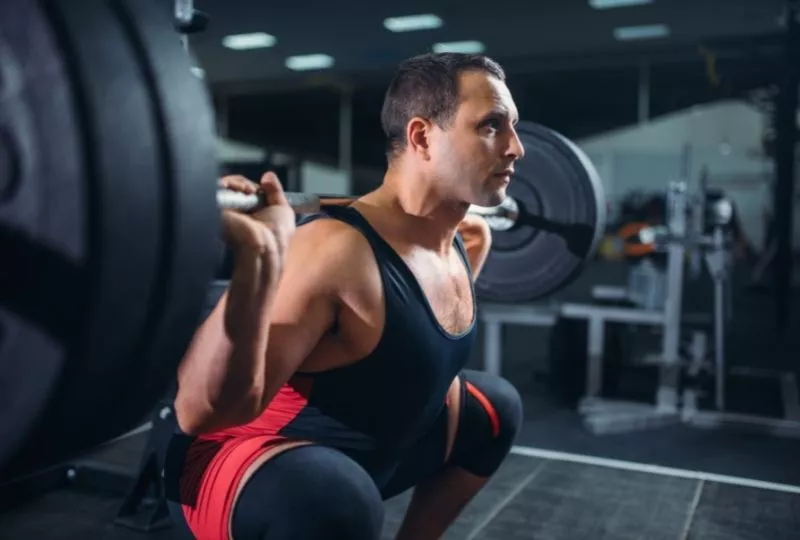
There are many factors to consider when calculating squat standards.
- Gender
- Age
- Body Weight
- The type of squat exercise
- Level of experience
- The usage of assisting tools
- Other possible factors
Gender is an obvious factor. Biologically, men are capable of producing more strength and power than women, being stronger relative to lean body mass.
While this is the case, men will also see a drop-off in performance with age. Many men peak at 19 years of age and gradually decrease to 40 years of age.
This already illustrates how different factors can make up to alter our squat standards.
Considerations for experience level, stance, and pre-existing injuries also play a role in determining your squat standard.
Different Types of Squat Exercises
Related: Do Squats Work Abs?
Typically, when we talk about maxing out on squats, we think about the barbell back squat. However, there are other styles to consider.
While they may not be the exercises you are pushing the most weight on, they should definitely be performed as they can assist in increasing overall strength and mass.
Bodyweight Squat
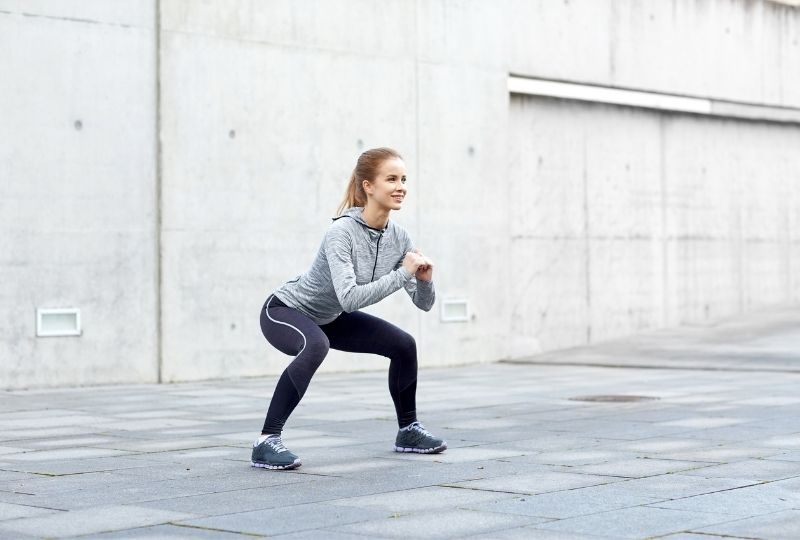
An absolute fundamental of human movement, the bodyweight squat is key to our daily function.
Using our hips, knees, and ankles, performing bodyweight squats is a great way to build functional strength for activities such as sitting down, standing up, and going up and down a set of stairs.
Being able to perform the bodyweight squat is also crucial to accurately squatting with heavier loads.
Bodyweight squats allow us to focus on correct technique and muscle activation through the entire movement. You can practice without worrying about the mountain of weight resting on your shoulders.
Bodyweight squats can also be a great exercise to perform as a warm-up prior to your weighted squat routine, as well as exercises such as deadlifts and lunges.
Goblet Squat
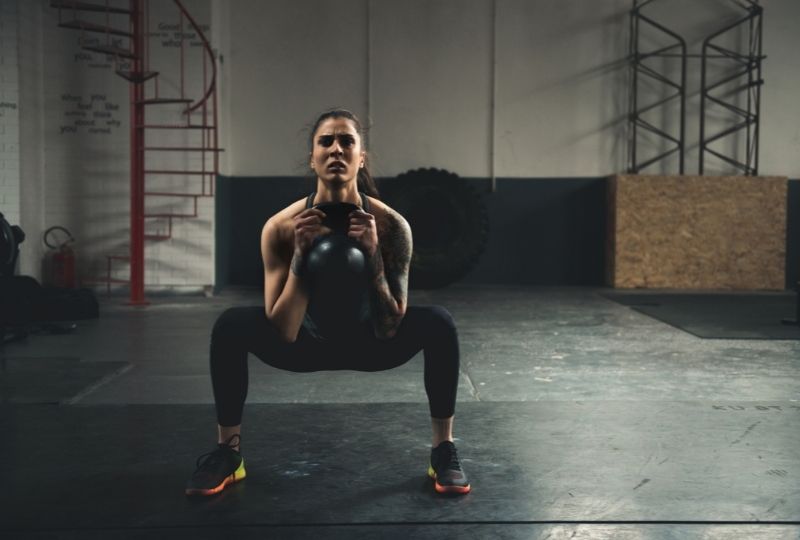
Performed with a kettlebell or dumbbell, the goblet squat is a natural progression from a bodyweight squat.
The goblet squat requires us to hold the weight in front of us at shoulder level.
This is a great position as it can help counterbalance the weight of our hips sitting back while helping us to remain upright for the entirety of the movement.
Due to this, they can also be a great way to cue new lifters on the correct technique and can be done incrementally with bodyweight squats to bridge the gap for smoother progression.
Back Squat
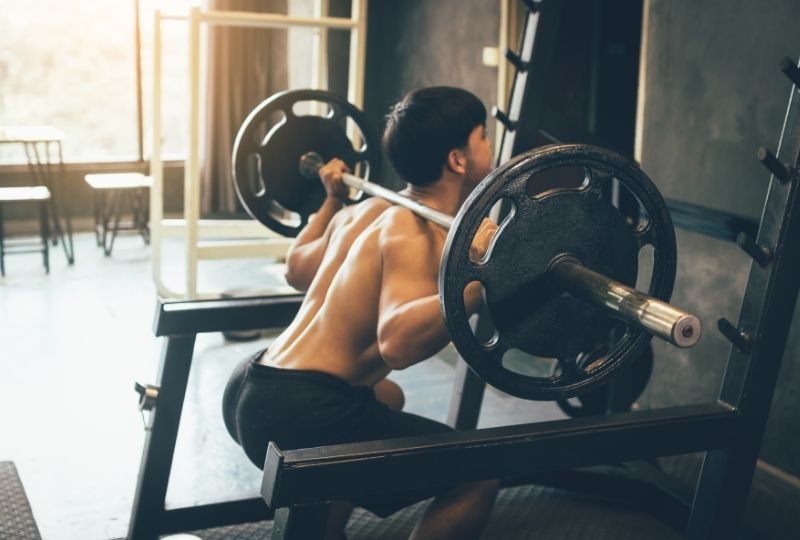
Battling the deadlift as the king of all lifts in the gym, the back squat is widely considered the ultimate exercise for building mass and strength for the lower body.
Called a back squat for the positioning of the bar on our backs, the movement requires huge amounts of strength from every part of the body.
While it takes the hips, knees, and ankles to perform the movement, the upper back, abdominals, and lower back all must be effectively activated and engaged.
Given this level of engagement, it is no surprise that back squats are used for building strength, power, and performance in athletes.
Front Squat
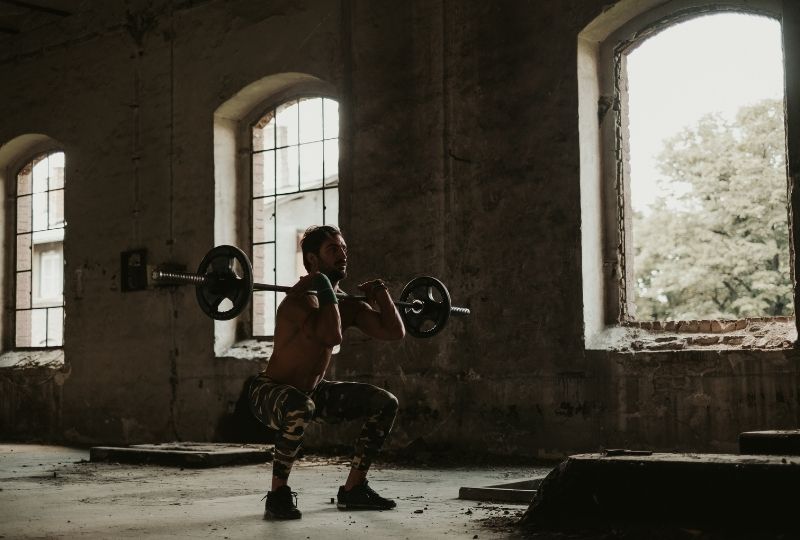
Similar in nature to its posterior counterpart, the front squat requires lifters to hold a barbell at the front when performing a squat.
Much like the goblet squat, the front squat positioning also assists in maintaining an upright position through the movement, as it counterbalances the weight of our hip going back.
Front squats are a great addition to any leg workout, with literature indicating them to be as effective in recruiting muscle fibers of the lower body as back squats.
The positioning of the front squat can be advantageous for decreasing spinal compression while reducing shearing force at the front of the knees.
This is a great exercise for those suffering from knee issues such as meniscus tears and anterior knee pain.
Overhead Squat
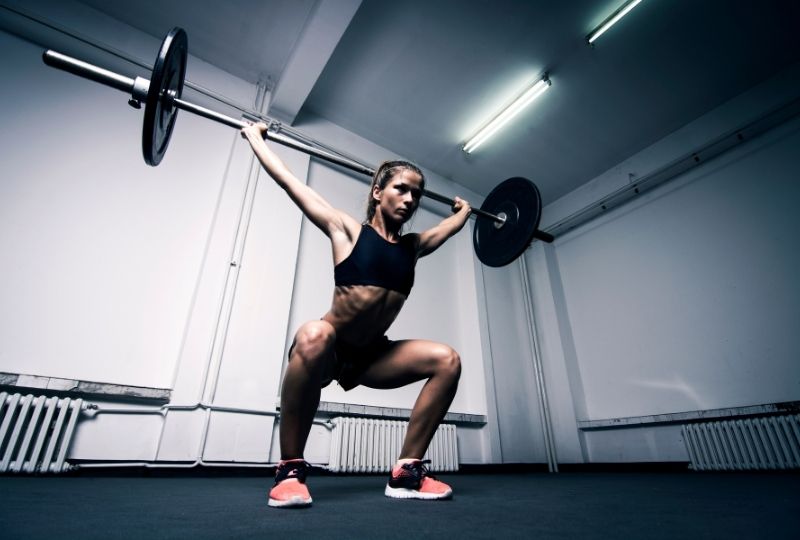
The overhead squat is one of the most technically advanced movements in the gym. It requires the lifter to perform the squat movement with the bar raised overhead in the snatch position.
The exercise can be incredibly challenging, requiring excellent mobility through the hips, knees, ankles, and most importantly, the thoracic spine.
When performing this style of squat for the first time, you will likely be met with a feeling of discomfort.
The movement feels counterintuitive as your arms stretch out above your head to stabilize the barbells while you lower yourself to the floor.
So, why do we do this to ourselves?
The overhead squat is a fantastic exercise for developing strength through the upper back and rotator cuff.
Due to the mobility requirements, the exercises are suitable for overhead athletes such as baseball pitchers, tennis players, and swimmers.
To perform this movement, flexibility and mobility routinely targeted at the hips, ankles, and thoracic spine is required.
Due to the difficulty, you should also perform your initial sets using a dowel rod, dumbbells, or light barbell to get used to the movement.
Want to know what you should be bench pressing? Check out What is the Average Bench Press for Men and for Women
The Average Squat Weight for Men and Women
The average squat is listed at 284 lbs (128.82 kg) for men and 161 lbs (73.0 kg) for women.
These figures are considered to be impressive lifts from intermediate-level lifters. Elite males register lifts up to 678 lbs (307.53 kg) and 391 lbs (177 kg) for females.
How much weight should I be able to squat?
Related: Powerbuilding Program (With PDF)
The weight you should be able to squat depends on several factors including, gender, age, weight, experience level, and type of squats.
A good marker is to measure based on body weight ratio (BW ratio).
For males, beginners 0.75x, novice 0.50x BW, intermediate 1.25x, advanced 1.5x and elite 2.00x
For females, beginners 0.50x, novice 1.25x BW, intermediate 1.50x, advanced 2.25x and elite 2.75x.
The body weight ratio in the table above is calculated by:
Example:
Formula = bodyweight x bodyweight ratio = Squat Weight
Male = 180lbs (BW) x 1.25 (Ratio) = 225 lbs
These are rough numbers that should be used as a guide, and factors such as personal skill level, and injury status should be taken into account when deciding on the correct weight.
how much should I be able to squat? (For Men)
Related: 100 Squats A Day Challenge
Male Squat Standards by Age (lbs)
| Age | Untrained | Novice | Intermediate | Advanced | Elite | |||||
| BW Ratio | 0.75x | 1.25x | 1.50x | 2.25x | 2.75x | |||||
| Type | Back | Front | Back | Front | Back | Front | Back | Front | Back | Front |
| 20-29 | 138 | 117 | 202 | 167 | 281 | 228 | 377 | 304 | 477 | 138 |
| 30-39 | 139 | 118 | 204 | 168 | 284 | 230 | 379 | 301 | 481 | 139 |
| 40-49 | 131 | 112 | 193 | 159 | 269 | 217 | 358 | 285 | 455 | 131 |
| 50-59 | 114 | 97 | 167 | 138 | 234 | 189 | 311 | 247 | 396 | 114 |
*Sources Strengthlevel.com
Male Squat Standards By Bodyweight (lbs)
| Body Weight | Untrained | Novice | Intermediate | Advanced | Elite | |||||
| BW Ratio | 0.50x | 0.75x | 1.25x | 1.50x | 2.00x | |||||
| Type | Back | Front | Back | Front | Back | Front | Back | Front | Back | Front |
| 110 | 71 | 66 | 122 | 99 | 164 | 142 | 226 | 193 | 295 | 248 |
| 120 | 84 | 75 | 128 | 111 | 184 | 156 | 249 | 209 | 321 | 267 |
| 130 | 98 | 85 | 144 | 123 | 203 | 170 | 271 | 225 | 346 | 285 |
| 140 | 110 | 94 | 160 | 134 | 221 | 183 | 293 | 240 | 370 | 302 |
| 150 | 123 | 104 | 175 | 145 | 239 | 196 | 313 | 255 | 393 | 318 |
| 160 | 136 | 113 | 190 | 156 | 256 | 209 | 333 | 269 | 415 | 334 |
| 170 | 148 | 121 | 204 | 166 | 273 | 220 | 352 | 283 | 437 | 349 |
| 180 | 160 | 130 | 219 | 176 | 290 | 232 | 371 | 296 | 457 | 363 |
| 190 | 172 | 139 | 233 | 186 | 306 | 243 | 389 | 308 | 477 | 377 |
| 200 | 184 | 147 | 246 | 196 | 321 | 254 | 406 | 320 | 497 | 391 |
| 210 | 195 | 155 | 259 | 205 | 336 | 265 | 423 | 332 | 515 | 404 |
| 220 | 207 | 163 | 272 | 214 | 351 | 275 | 440 | 344 | 534 | 417 |
| 230 | 218 | 170 | 285 | 233 | 365 | 285 | 456 | 355 | 551 | 429 |
| 240 | 229 | 178 | 297 | 231 | 370 | 295 | 471 | 366 | 569 | 441 |
| 250 | 239 | 185 | 310 | 240 | 379 | 304 | 487 | 376 | 585 | 452 |
| 260 | 250 | 193 | 322 | 248 | 393 | 313 | 502 | 387 | 602 | 464 |
| 270 | 260 | 200 | 333 | 256 | 407 | 323 | 516 | 397 | 618 | 475 |
| 280 | 270 | 207 | 345 | 264 | 420 | 331 | 530 | 407 | 633 | 485 |
| 290 | 280 | 214 | 356 | 272 | 433 | 340 | 544 | 416 | 648 | 496 |
| 300 | 290 | 220 | 367 | 279 | 457 | 348 | 558 | 425 | 663 | 506 |
| 310 | 299 | 227 | 378 | 287 | 470 | 357 | 571 | 435 | 678 | 516 |
how much should I be able to squat? (For Women)
Female squat standards by age (lbs)
| Age | Untrained | Novice | Intermediate | Advanced | Elite | |||||
| BW Ratio | 0.50x | 0.75x | 1.25x | 1.50x | 2.00x | |||||
| Type | Back | Front | Back | Front | Back | Front | Back | Front | Back | Front |
| 20-29 | 66 | 67 | 106 | 97 | 160 | 136 | 225 | 180 | 297 | 229 |
| 30-39 | 66 | 67 | 107 | 98 | 161 | 137 | 227 | 182 | 299 | 231 |
| 40-49 | 62 | 64 | 101 | 93 | 153 | 130 | 215 | 172 | 283 | 218 |
| 50-59 | 54 | 55 | 88 | 81 | 133 | 113 | 180 | 150 | 246 | 190 |
*Sources Strengthlevel.com
Female Squat Standards By Bodyweight (lbs)
| Body Weight | Untrained | Novice | Intermediate | Advanced | Elite | |||||
| BW Ratio | 0.50x | 0.75x | 1.25x | 1.50x | 2.00x | |||||
| Type | Back | Front | Back | Front | Back | Front | Back | Front | Back | Front |
| 90 | 40 | 47 | 71 | 72 | 114 | 104 | 167 | 142 | 226 | 193 |
| 100 | 46 | 52 | 79 | 78 | 124 | 111 | 179 | 150 | 241 | 202 |
| 110 | 52 | 56 | 87 | 84 | 134 | 118 | 191 | 158 | 254 | 210 |
| 120 | 58 | 61 | 95 | 89 | 143 | 124 | 202 | 165 | 267 | 217 |
| 130 | 63 | 65 | 102 | 94 | 152 | 130 | 212 | 172 | 278 | 224 |
| 140 | 69 | 69 | 109 | 98 | 160 | 135 | 222 | 178 | 290 | 231 |
| 150 | 74 | 72 | 115 | 103 | 168 | 141 | 231 | 184 | 300 | 237 |
| 160 | 79 | 76 | 121 | 107 | 175 | 146 | 240 | 190 | 310 | 244 |
| 170 | 84 | 79 | 127 | 111 | 183 | 150 | 248 | 195 | 320 | 249 |
| 180 | 89 | 83 | 133 | 115 | 190 | 155 | 256 | 200 | 329 | 255 |
| 190 | 93 | 86 | 139 | 119 | 196 | 159 | 264 | 205 | 338 | 260 |
| 200 | 98 | 89 | 144 | 123 | 203 | 163 | 271 | 210 | 346 | 265 |
| 210 | 102 | 92 | 150 | 126 | 209 | 168 | 279 | 215 | 354 | 270 |
| 220 | 106 | 95 | 155 | 130 | 215 | 171 | 286 | 219 | 362 | 275 |
| 230 | 118 | 98 | 160 | 133 | 221 | 175 | 292 | 224 | 370 | 280 |
| 240 | 122 | 101 | 164 | 136 | 227 | 179 | 299 | 228 | 377 | 284 |
| 250 | 118 | 103 | 169 | 139 | 232 | 183 | 305 | 232 | 384 | 288 |
| 260 | 122 | 106 | 174 | 142 | 238 | 186 | 311 | 236 | 391 |
Need help increasing leg mass? Try our 14 Effective Leg Press Alternative Exercises (with videos)
Tips to Improve Your Strength Standards
Related: Should You Do 100 Jumping Jacks A Day?
- Train Accessory Muscles
An excellent way to improve your squat strength standards is to target your accessory muscles. The squat is a large compound movement, meaning it uses more than one muscle group.
Training these muscle groups in a single exercise is beneficial. However, when there are a lot of muscles working together, weaker muscles can’t always be identified during heavy lifts.
By training these muscles independently, we can improve their performance. Reducing areas of weakness and improving overall lifting capacity.
- Increase Training Intensity
Training intensity has long been associated with gains in performance. However, when we hit a plateau in our lifts or feel that our workouts have become stale, our intensity can drop off.
This does not mean that we always need to lift heavy for every session. Rather, lift with the correct technique and intensity for every lift.
This can be done by maintaining explosive power during squats and deadlifts, deload weeks, and lighter sessions.
- Train Isometrics
Isometrics is a contraction that is held for a duration of time without a joint moving and can be effective in increasing performance.
Research has indicated contracting isometrically can improve hypertrophy and maximal force.
Exercises such as pause squats and planks are a great way to improve performance. The act of holding a position under resistance has been noted to improve tendon function and structure.
- Warm-Up
Warming up is an essential part of training as it prepares our bodies for our upcoming lifts.
When we perform heavy lifts, there are many components coming together to make it happen.
Appropriately preparing our nervous system, warming up and increasing blood flow, and activating muscles can go a long way toward improving our lifts.
Try dynamically stretching hips, activating glutes, and mobilizing ankles, hips, and the thoracic spine.
Taking 5-10 minutes before your session can greatly improve your performance.
Frequently Asked Questions

What is a good squat weight?
A good squat weight depends on the individual. A good marker is the bodyweight ratio.
For men, being able to lift 1.25x – 1.50x your bodyweight and 0.75x – 1.25x for women is a simple and effective way to calculate ideal weight based on body weight.
How much should I be able to front squat?
When figuring out a good front squat weight, considerations such as weight, age, and experience need to be made.
Using the bodyweight ratio for novice and intermediate experience levels of 1.00 – 1.25x for men and 0.75 – 1.00x for women can help determine the right weight for you.
How much should I be able to back squat?
To determine an appropriate back squat weight, factors such as experience, body weight, age, and gender all need to be taken into consideration.
A good way to determine your back squat weight is to employ the squat to bodyweight ratio.
For the novice and intermediate lifters, you should aim for 0.75x – 1.50x your body weight for men, and 0.50x – 1.25x for women.
This isn’t the only consideration. However, it will give you a starting point to determine the right weight for you.
What should the average person be able to squat?
The average person should be able to perform 0.75x their body weight for men, and 0.50x for women. These are considered beginner levels.
Starting at this weight can help to determine the right resistance for you while representing a good baseline marker for non-lifters performing daily living functions.
Is 2x bodyweight squat good?
Being able to squat two times your body weight is considered advanced. While this is achievable, doing so may not be doable for all who step under the bar.
How much can the average man squat?
The average squat for males is 284 lbs (128.82 kg). This is considered intermediate and a great lift. When formulating this number, it must be noted that not all lifters will be able to hit this number.
Ultimately, it represents the average among lifters from beginner to elite. Elite male lifters squat up to 679 lbs (307 lbs) at a 310 lbs bodyweight bracket.
Final Thoughts
Squatting is considered one of the cornerstone exercises both inside the gym and in terms of functional movements.
Its ability to work our entire body and build mass and strength is nearly unmatched.
While it can be difficult to find your ideal squat weight, we try to balance lifting correctly with the desire to lift with our ego.
We should focus on choosing a weight that allows us to perform quality repetitions and maximize results, instead of bowing to peer pressure.
So, how does your squat stack up, and what are some of your squat goals? Let me know in the comments below.

